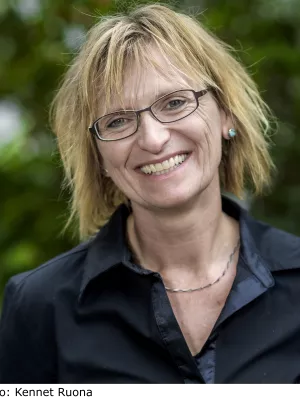
Natascha Kljun
Professor

The carbon balance of a managed boreal landscape measured from a tall tower in northern Sweden
Författare
Summary, in English
Boreal forests exchange large amounts of carbon dioxide (CO2) with the atmosphere. A managed boreal landscape usually comprises various potential CO2 sinks and sources across forest stands of varying age classes, clear-cut areas, mires, and lakes. Due to this heterogeneity and complexity, large uncertainties exist regarding the net CO2 balance at the landscape scale. In this study, we present the first estimate of the net CO2 exchange over a managed boreal landscape (∼68 km2) in northern Sweden, based on tall tower eddy covariance measurements. Our results suggest that from March 1, 2016 to February 28, 2018, the heterogeneous landscape was a net CO2 sink with a 2-year mean uptake of −87 ± 6 g C m−2 yr−1. Due to an earlier and warmer spring and sunnier autumn, the landscape was a stronger CO2 sink during the first year (−122 ± 8 g C m−2) compared to the second year (−52 ± 9 g C m−2). Footprint analysis shows that 87% of the CO2 flux measurements originated from forests, whereas mires, clear-cuts, lakes, and grassland contributed 11%, 1%, 0.7%, and 0.2%, respectively. Altogether, the CO2 sink strength of the heterogeneous landscape was up to 38% lower compared to the sink strength of a mature stand surrounding the tower. Overall, this study suggests that the managed boreal landscape acted as a CO2 sink and advocates tall tower eddy covariance measurements to improve regional carbon budget estimates.
Avdelning/ar
- Centrum för miljö- och klimatvetenskap (CEC)
- MERGE: ModElling the Regional and Global Earth system
- BECC: Biodiversity and Ecosystem services in a Changing Climate
Publiceringsår
2019
Språk
Engelska
Sidor
29-41
Publikation/Tidskrift/Serie
Agricultural and Forest Meteorology
Volym
274
Länkar
Dokumenttyp
Artikel i tidskrift
Förlag
Elsevier
Ämne
- Physical Geography
- Forest Science
Nyckelord
- Boreal landscape
- Tall tower eddy covariance
- Footprint analysis
- Land cover heterogeneity
- CO2 Flux
Status
Published
ISBN/ISSN/Övrigt
- ISSN: 0168-1923